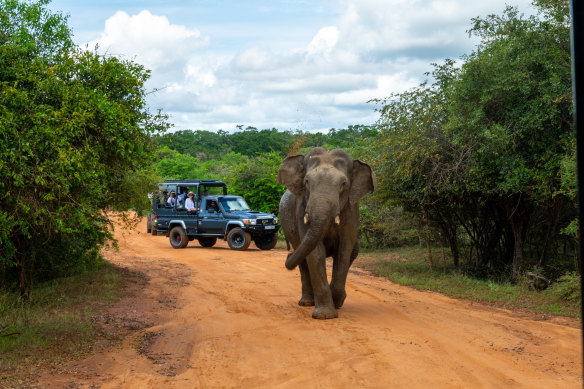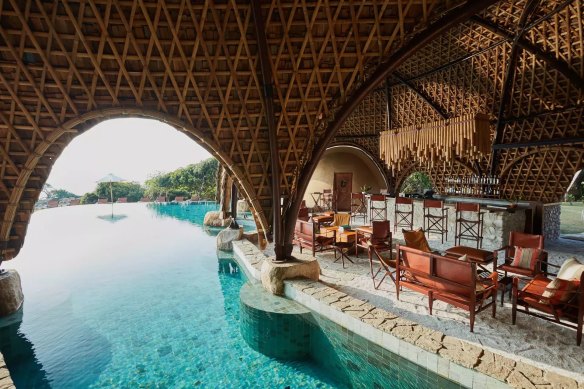This was published 8 months ago
Think beyond Africa. The unexpected safari destination you should explore
By Paul Ewart
I hold on tightly to the side of the safari jeep as clouds of scorched, red dust are kicked up in our wake. It’s the wrong side of 7am and, as I wipe sleep from my eyes, I spy a large crocodile basking in the morning sun by the side of a small lake.
My gaze darts upwards and I see a family of grey langur monkeys sitting high in the canopy of a tree, their gesticulating tails silhouetted against the candy floss-hued dawn sky. Then the khaki-clad guide next to me cries out excitedly, “Elephants!” I crane my neck eagerly to see five of the gigantic mammals treat a cluster of bushes like an all-you-can-eat breakfast buffet.

Savvy travellers are increasingly waking up to the wealth of wildlife within the island of Sri Lanka
While Africa has historically reigned as the go-to destination for safaris, savvy travellers are increasingly waking up to the wealth of wildlife within the island of Sri Lanka. From tropical low wetlands and mangroves to rainforests and savannahs that play home to leopards, elephants and sloth bears, the country is one of the world’s biodiversity hot spots, with 26 designated national parks housing hundreds of species.
I begin my Sri Lankan adventure in its capital city of Colombo. I check into the boutique Uga Residence (soon to be rebranded as Residence on Park Street). The hotel is the perfect base from which to get an overview of the capital’s main attractions.
Less than five hours’ drive from Colombo, Yala National Park boasts the most dense leopard population on earth. Yala is my first safari port of call, and I check into Wild Coast Tented Lodge. Easily the most luxe safari lodge in the country, the Relais & Chateaux property has won accolades for its epic location: the Indian Ocean on one side and jungle on the other. Accommodation comprises 28 tent-style “cocoons”, each of which comes with plunge pools, four-poster beds and oversized copper baths.

Stylish safari cocoons at Wild Coast Tented Lodge, Sri Lanka.
Visitors here have the option of inclusive daily dawn and afternoon game drives in the company of skilled guides. “Early mornings are the best for leopards, as this is when they like to mark their territories,” our guide, Avi, tells us. On our final morning, we are rewarded with a wildlife doco- worthy encounter: high in an Indian ironwood tree, we see a mother leopard and her cub with a freshly caught young deer.
Changing location to the nearby Uga Chena Huts, also nestled deep within Yala, we join twice-daily drives during which our critter count keeps increasing, with sightings including a rare sloth bear. The resort’s immersive location means that the national park’s wildlife population regularly spills over into its grounds. I share pathways with peacocks, my daily dips in the pool are watched by a gaggle of grey langur monkeys, and from the beachfront one night we see several elephants in the distance.
Veering west, we reach our next safari stop: Udawalawe National Park. It is known as the best place in Asia for observing elephants in the wild. On our safari to the park — an experience offered at Anantara Peace Haven Tangalle (one of the country’s top beach resorts) — we clock up at least 20 elephant sightings, alongside herds of water buffalo.
Travelling northwest, we eventually reach Wilpattu National Park. One of the oldest and largest parks in the country, Wilpattu is known for its leopard population, while nearby Minneriya National Park is famed for its annual “Gathering”, where elephants from all over converge together.
Uga Ulagalla resort sits between these two national parks (and offers daily safari excursions to both). Spread over 23 lush hectares, with a century-old colonial mansion at its centre, Ulagalla feels like part-resort, part-wildlife sanctuary. One evening we’re temporarily unable to return to our villa as a wild elephant has been spotted on the pathway outside it!
The writer was a guest of Uga Residence, Wild Coast, Uga Chena Huts, Anantara Peace Haven Tangalle Resort and Uga Ulagalla.
Get the best of Sunday Life magazine delivered to your inbox every Sunday morning. Sign up here for our free newsletter.